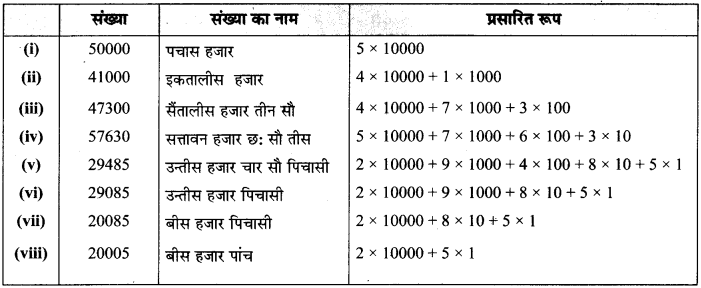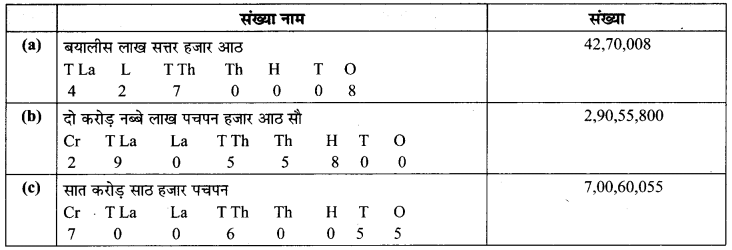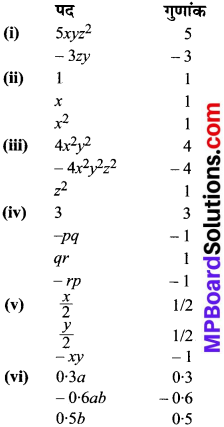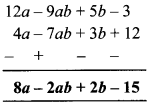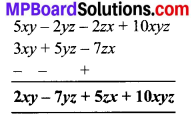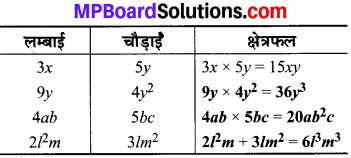MP Board Class 8th Maths Solutions Chapter 9 बीजीय व्यंजक एवं सर्वसमिकाएँ Ex 9.3
प्रश्न 1.
निम्नलिखित युग्मों में प्रत्येक के व्यंजकों का गुणन कीजिए –
- 4p, q+ r
- ab, a – b
- a + b, 7a2 – b2
- a2 – 9, 4a
- pq + qr + rp, 0
हल:
1. 4p x (q + r) = 4p x q + 4p x r
= 4pq + 4pr
2. ab x (a – b) = ab x a – ab x b
= a2b – ab2
3. (a + b) x 7a2b2 = a x 7a2b2 + b x 7a2b2
= 7a2b2 + 7a2b3
4. (a2 – 9) x 4a = a2 x 4a – 9 x 4a
= 4a3 – 36a
5. (pq + qr + rp) x 0 = 0
![]()
प्रश्न 2.
सारणी पूरी कीजिए –
हल:
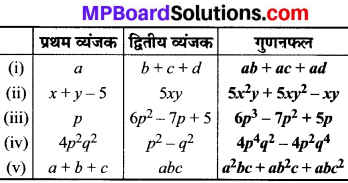
प्रश्न 3.
गुणनफल ज्ञात कीजिए –
- (a2) x (2a22) x (4a26)
- (\(\frac{2}{3}\)xy) x (\(\frac{-9}{10}\)x2y2)
- (\(\frac{-10}{3}\)pq3) – (\(\frac{6}{5}\)p3q)
- x × x2 × x3 × x4.
हल:
1. (a2) – (2a22) x (4a26)
= (1 x 2 x 4) x (a2 x a22 x a26)
= 8a2+22+26 = 8a50
2.
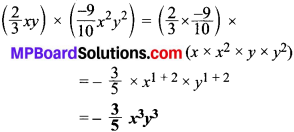
3.
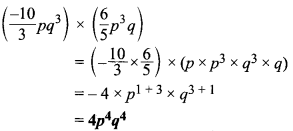
4. x × x2 × x3 × x4 = x1+2+3+4 = x10
प्रश्न 4.
(a) 3 x (4x – 5) + 3 को सरल कीजिए और
- x = 3 एवं
- x = 1 के लिए इसका मान ज्ञात कीजिए।
(b) a (a + a + 1) + 5 को सरल कीजिए और
- a = 0
- a = 1 एवं
- a = – 1 के लिए इसका मान ज्ञात कीजिए।
हल:
(a) 3 x (4x – 5) + 3
= 3x × 4x – 3x × 5 + 3
= 12x2 – 15x + 3
1. जब x = 3 हो, तब
3x (4x – 5) + 3 = 3 x 3 (4 x 3 – 5) + 3
= 9 (12 – 5) + 3
= 9 x 7 + 3 = 63 + 3 = 66
2. जब x = \(\frac{1}{2}\) हो, तब
3x (4x – 5) + 3 = 3 x \(\frac{1}{2}\) (4 x \(\frac{1}{2}\) – 5) + 3
= \(\frac{3}{2}\) (2 – 5) + 3
= \(\frac{3}{2}\) x (-3) + 3 = – \(\frac{1}{2}\) + 3
= \(\frac{-9+6}{2}\) = \(\frac{-3}{2}\)
(b) a(a2 + a + 1) + 5 = a3 + a2 + a + 5
1. जब a = 0 हो, तब
a(a2 + a + 1) + 5 = 0 (0 + 0 + 1) +5
= 0 (1) + 5 = 0 + 5 = 5
2. जब a = 1 हो, तब
a (a2 + a + 1) + 5 = 1 (12 + 1 + 1) + 5
= 1 (3) + 5 = 3 + 5 = 8
3. जब a = – 1 हो, तब
a (a2 + a + 1) + 5 = (-1) (1 – 1 + 1) + 5
= (-1) x 1 + 5
= – 1 + 5 = 4
![]()
प्रश्न 5.
(a) p (p – q), q(q – r) एवं r (r – p) को जोडिए।
(b) 2x (z – x – y) एवं 2y (z – y – x) को जोड़िए।
(c) 4l (10n – 3m + 21) में से 3l (l – 4l + 5n) को – घटाइए।
(d) 4c (- a + b + c) में से 3a (a + b + c) – 2b (a – b + c) को घटाइए।
हल:
(a) p (p – q) + q (q – r) + r (r – p)
= p x p – p x q + q x q – q x r + r x r – r x p
= p2 – pq + q2 – qr + r2 – rp
= p2 + q2 + r2 – pq – qr – rp
(b) 2x (z – x – y) + 2y (z – y – x)
= 2xz – 2x2 – 2xy + 2yz – 2y2 – 2xy
= 2x2 – 2y2 – 4xy + 2yz + 2zx
(c) 4l (10n – 3m + 2l) – 3l (1 – 4m + 5n)
= 40ln – 12lm +8l2 – 3l2 + 12lm – 15ln
= 8l2 – 3l2 – 12lm + 12lm + 40ln – 15In
= 5l2 + 25ln
(d) 4c(- a + b + c) – [3a (a + b + c) 2b(a – b + c)]
= 4c(- a + b + c) – 3a (a + b + c) + 2b(a – b + c)
= – 4ca + 4bc + 4c2 – 3a2 – 3ab – 3ac + 2ab – 2b2 +2bc
= – 3a2 – 2b2 + 4c2 – 3ab + 2ab + 4bc + 2bc – 4ca – 3ac
= – 3a2 – 2b2 + 4c2 – ab + 6bc – 7ca
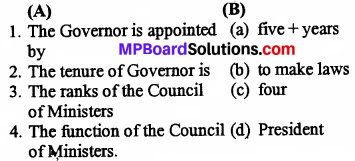 Answer:
Answer:
